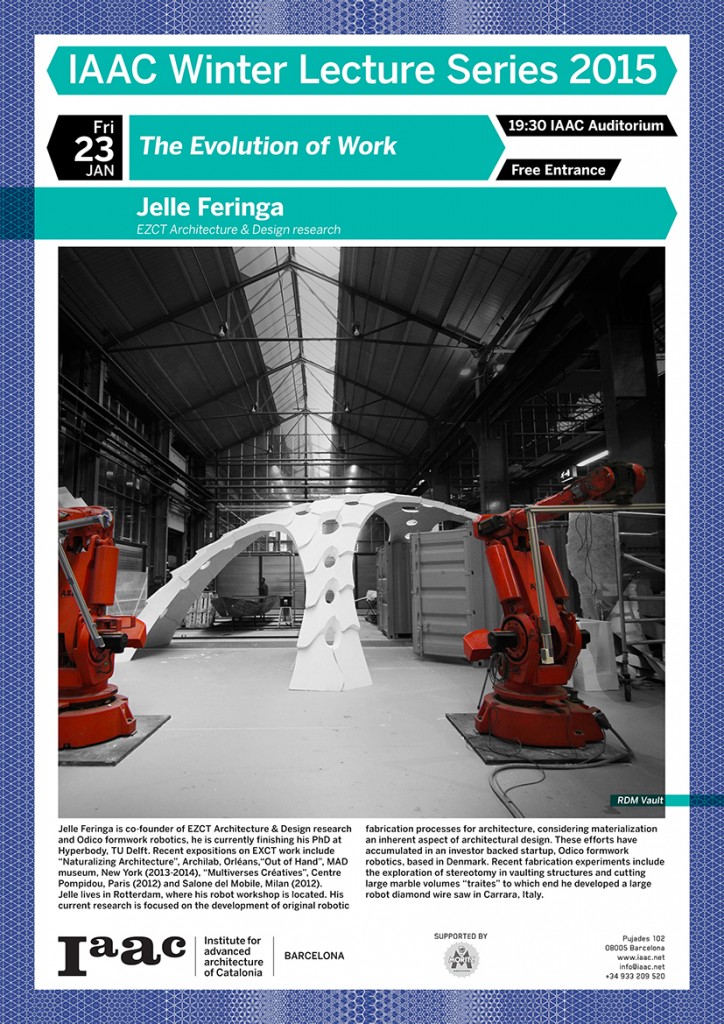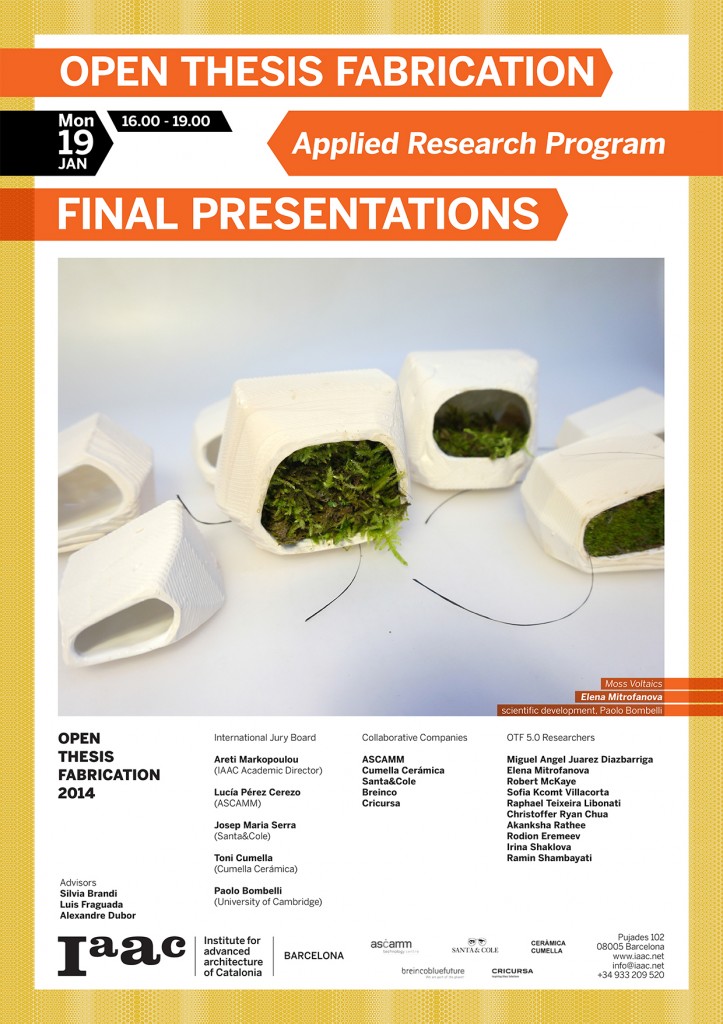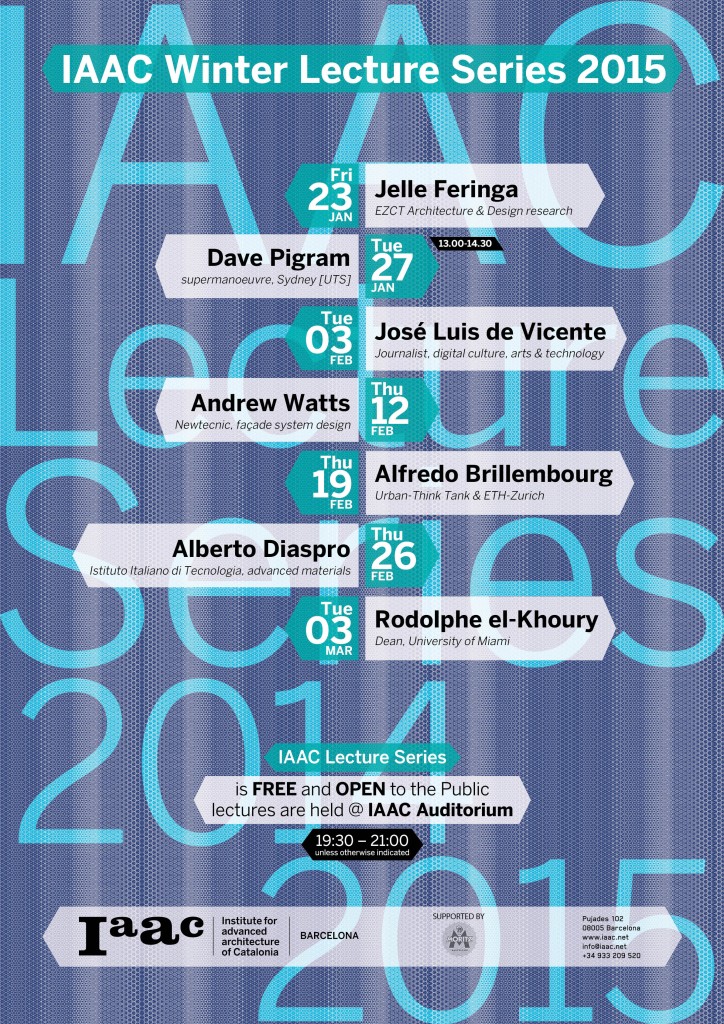IaaC Blog
Inside the Institute
MAA 2014-2015
MAA 02
MAI
Valldaura Labs
Open Thesis Fabrication
Research Trips
Category Archives: IAAC event
Tuesday 27th of January // Dave Pigram // Experiments in Design and Fabrication
Also posted in Lecture Series Leave a comment
Jelle Feringa // The Evolution of Work
Tonight we had the pleasure of hosting Jelle Feringa as the first of the IAAC Winter Lecture Series 2015. Jelle spoke about the evolution of work, recovering lost ground through the simultaneity of craft, economy and design. In particular in a context where the real-estate and following financial crises has made terrible onslaught on architectural practice.
Now, there is an emergence of new architectural practices whose new found modus operandi has a strong technological basis. A number of promising practices have been surfacing over recent years, leveraging architectural robotics beyond mere conceptual merit and stepping into the industrial arena.
In 1996, Bernard Cache’s company Objectile set up a factory utilising CNC milling machines. In 2000, architect Bill Massie built the Big Belt house, and more than a decade later companies like Facit Homes are revisiting the idea of the house as a product, where CNC is the enabling technology. Do these projects suggest a reconsideration of the objectives of early Modernism, to provide affordable and modern houses of architectural ambition? Where novel manufacturing processes, ranging from CNC to robotics are here to anew the architectural profession. To what extent is architecture’s the newfound vicinity of construction desirable, can architecture recover lost ground?
After the lecture Jelle, along with Dave Pigram, and IAAC Robotic Fabrication expert Alexandre Dubor, will all be developing a Robotic Fabrication Workshop, developing hot-wire cutting processes with the Kuka robot.
Also posted in Lecture Series, Uncategorized Tagged crafting, economy, evolution, fabrication, Jelle Feringa, potentials, robotic fabrication Leave a comment
Open Thesis Fabrication // FINAL PRESENTATIONS
Today were the Open Thesis Fabrication 2014 Final Presentations. Open Thesis Fabrication is an Applied Research post graduate program focussed on the development of a specific research agenda in the field of digital design and fabrication. The OTF program researchers develop and complete full-scale prototypes using advanced CNC machinery, innovative material solutions, and smart energy applications.
The program is also unique as it is developed hand in hand with Industry Partners, with the objective of offering the researchers the possibility to engage in a semi-professional environment, and develop a project with the support and expertise of individuals and institutions that are commercially involved in their field of research.
The collaborative companies are: ASCAMM, Cumella Cerámica, Santa&Cole, Breinco and Cricursa.
The final presentations of OTF researchers took place with an international jury board: Areti Markopoulou – IAAC Academic Director, Lucía Pérez Cerezo – ASCAMM, Josep Maria Serra – Santa&Cole, Toni Cumella – Cumella Cerámica, and Paolo Bombelli – University of Cambridge; as well as the presence of the program advisors Silvia Brandi, Alexandre Dubor and Luis Fraguada.
This year’s projects feature green energy systems, small scale desalination devices, the implementation of ceramics with robotic fabrication, natural material research for the implementation of 3D printing on the architectural scale, and much more.
Also posted in IaaC Life, Uncategorized Tagged 2015, academy, applied research, ascamm, breinco, cricursa, cumella ceramica, fabrication, industry, material science, Open Thesis Fabrication, santa&cole, testing Leave a comment
Friday 23rd of January // Jelle Feringa // The Evolution of Work
Also posted in Lecture Series, Uncategorized Tagged crafting, economy, evolution, fabrication, Jelle Feringa, potentials, robotic fabrication Leave a comment




